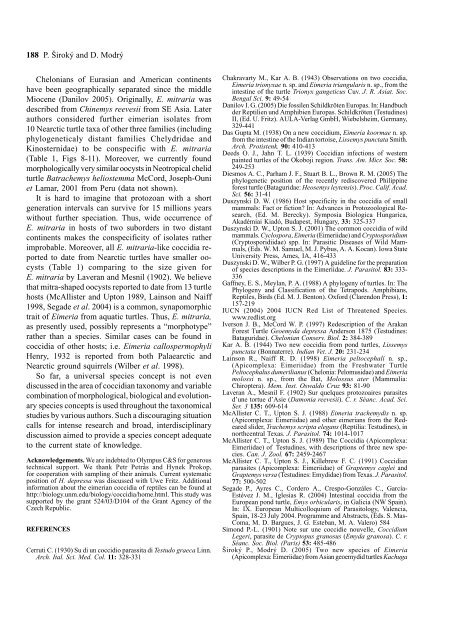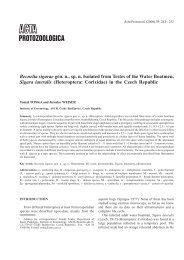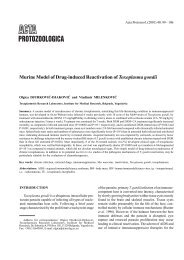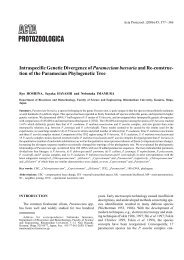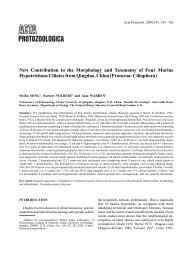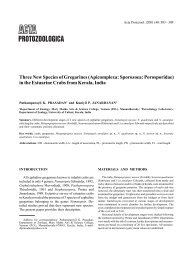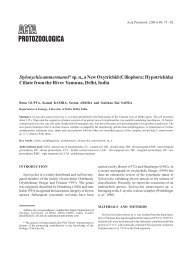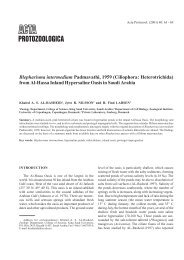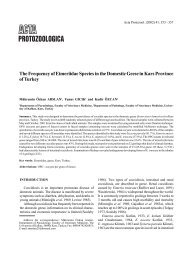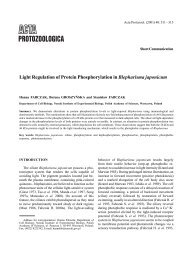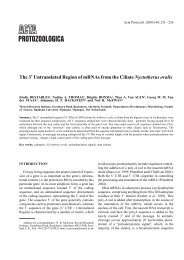Two Eimerian Coccidia (Apicomplexa: Eimeriidae) from the Critically ...
Two Eimerian Coccidia (Apicomplexa: Eimeriidae) from the Critically ...
Two Eimerian Coccidia (Apicomplexa: Eimeriidae) from the Critically ...
- No tags were found...
Create successful ePaper yourself
Turn your PDF publications into a flip-book with our unique Google optimized e-Paper software.
188 P. Široký and D. ModrýChelonians of Eurasian and American continentshave been geographically separated since <strong>the</strong> middleMiocene (Danilov 2005). Originally, E. mitraria wasdescribed <strong>from</strong> Chinemys reevesii <strong>from</strong> SE Asia. Laterauthors considered fur<strong>the</strong>r eimerian isolates <strong>from</strong>10 Nearctic turtle taxa of o<strong>the</strong>r three families (includingphylogeneticaly distant families Chelydridae andKinosternidae) to be conspecific with E. mitraria(Table 1, Figs 8-11). Moreover, we currently foundmorphologically very similar oocysts in Neotropical chelidturtle Batrachemys heliostemma McCord, Joseph-Ouniet Lamar, 2001 <strong>from</strong> Peru (data not shown).It is hard to imagine that protozoan with a shortgeneration intervals can survive for 15 millions yearswithout fur<strong>the</strong>r speciation. Thus, wide occurrence ofE. mitraria in hosts of two suborders in two distantcontinents makes <strong>the</strong> conspecificity of isolates ra<strong>the</strong>rimprobable. Moreover, all E. mitraria-like coccidia reportedto date <strong>from</strong> Nearctic turtles have smaller oocysts(Table 1) comparing to <strong>the</strong> size given forE. mitraria by Laveran and Mesnil (1902). We believethat mitra-shaped oocysts reported to date <strong>from</strong> 13 turtlehosts (McAllister and Upton 1989, Lainson and Naiff1998, Segade et al. 2004) is a common, synapomorphictrait of Eimeria <strong>from</strong> aquatic turtles. Thus, E. mitraria,as presently used, possibly represents a “morphotype”ra<strong>the</strong>r than a species. Similar cases can be found incoccidia of o<strong>the</strong>r hosts; i.e. Eimeria callospermophyliHenry, 1932 is reported <strong>from</strong> both Palaearctic andNearctic ground squirrels (Wilber et al. 1998).So far, a universal species concept is not evendiscussed in <strong>the</strong> area of coccidian taxonomy and variablecombination of morphological, biological and evolutionaryspecies concepts is used throughout <strong>the</strong> taxonomicalstudies by various authors. Such a discouraging situationcalls for intense research and broad, interdisciplinarydiscussion aimed to provide a species concept adequateto <strong>the</strong> current state of knowledge.Acknowledgements. We are indebted to Olympus C&S for generoustechnical support. We thank Petr Petrás and Hynek Prokop,for cooperation with sampling of <strong>the</strong>ir animals. Current systematicposition of H. depressa was discussed with Uwe Fritz. Additionalinformation about <strong>the</strong> eimerian coccidia of reptiles can be found athttp://biology.unm.edu/biology/coccidia/home.html. This study wassupported by <strong>the</strong> grant 524/03/D104 of <strong>the</strong> Grant Agency of <strong>the</strong>Czech Republic.REFERENCESCerruti C. (1930) Su di un coccidio parassita di Testudo graeca Linn.Arch. Ital. Sci. Med. Col. 11: 328-331Chakravarty M., Kar A. B. (1943) Observations on two coccidia,Eimeria trionyxae n. sp. and Eimeria triangularis n. sp., <strong>from</strong> <strong>the</strong>intestine of <strong>the</strong> turtle Trionyx gangeticus Cuv. J. R. Asiat. Soc.Bengal Sci. 9: 49-54Danilov I. G. (2005) Die fossilen Schildkröten Europas. In: Handbuchder Reptilien und Amphibien Europas. Schildkröten (Testudines)II, (Ed. U. Fritz). AULA-Verlag GmbH, Wiebelsheim, Germany,329-441Das Gupta M. (1938) On a new coccidium, Eimeria koormae n. sp.<strong>from</strong> <strong>the</strong> intestine of <strong>the</strong> Indian tortoise, Lissemys punctata Smith.Arch. Protistenk. 90: 410-413Deeds O. J., Jahn T. L. (1939) <strong>Coccidia</strong>n infections of westernpainted turtles of <strong>the</strong> Okoboji region. Trans. Am. Micr. Soc. 58:249-253Diesmos A. C., Parham J. F., Stuart B. L., Brown R. M. (2005) Thephylogenetic position of <strong>the</strong> recently rediscovered Philippineforest turtle (Bataguridae: Heosemys leytensis). Proc. Calif. Acad.Sci. 56: 31-41Duszynski D. W. (1986) Host specificity in <strong>the</strong> coccidia of smallmammals: Fact or fiction? In: Advances in Protozoological Research,(Ed. M. Berecky). Symposia Biologica Hungarica,Akadémiai Kiadó, Budapest, Hungary, 33: 325-337Duszynski D. W., Upton S. J. (2001) The common coccidia of wildmammals. Cyclospora, Eimeria (<strong>Eimeriidae</strong>) and Cryptosporidium(Cryptosporidiidae) spp. In: Parasitic Diseases of Wild Mammals,(Eds. W. M. Samuel, M. J. Pybus, A. A. Kocan). Iowa StateUniversity Press, Ames, IA, 416-433Duszynski D. W., Wilber P. G. (1997) A guideline for <strong>the</strong> preparationof species descriptions in <strong>the</strong> <strong>Eimeriidae</strong>. J. Parasitol. 83: 333-336Gaffney, E. S., Meylan, P. A. (1988) A phylogeny of turtles. In: ThePhylogeny and Classification of <strong>the</strong> Tetrapods. Amphibians,Reptiles, Birds (Ed. M. J. Benton). Oxford (Clarendon Press), 1:157-219IUCN (2004) 2004 IUCN Red List of Threatened Species.www.redlist.orgIverson J. B., McCord W. P. (1997) Redescription of <strong>the</strong> ArakanForest Turtle Geoemyda depressa Anderson 1875 (Testudines:Bataguridae). Chelonian Conserv. Biol. 2: 384-389Kar A. B. (1944) <strong>Two</strong> new coccidia <strong>from</strong> pond turtles, Lissemyspunctata (Bonnaterre). Indian Vet. J. 20: 231-234Lainson R., Naiff R. D. (1998) Eimeria peltocephali n. sp.,(<strong>Apicomplexa</strong>: <strong>Eimeriidae</strong>) <strong>from</strong> <strong>the</strong> Freshwater TurtlePeltocephalus dumerilianus (Chelonia: Pelomusidae) and Eimeriamolossi n. sp., <strong>from</strong> <strong>the</strong> Bat, Molossus ater (Mammalia:Chiroptera). Mem. Inst. Oswaldo Cruz 93: 81-90Laveran A., Mesnil F. (1902) Sur quelques protozoaires parasitesd’une tortue d’Asie (Damonia reevesii). C. r. Séanc. Acad. Sci.Ser. 3 135: 609-614McAllister C. T., Upton S. J. (1988) Eimeria trachemydis n. sp.(<strong>Apicomplexa</strong>: <strong>Eimeriidae</strong>) and o<strong>the</strong>r eimerians <strong>from</strong> <strong>the</strong> Redearedslider, Trachemys scripta elegans (Reptilia: Testudines), innorthcentral Texas. J. Parasitol. 74: 1014-1017McAllister C. T., Upton S. J. (1989) The <strong>Coccidia</strong> (<strong>Apicomplexa</strong>:<strong>Eimeriidae</strong>) of Testudines, with descriptions of three new species.Can. J. Zool. 67: 2459-2467McAllister C. T., Upton S. J., Killebrew F. C. (1991) <strong>Coccidia</strong>nparasites (<strong>Apicomplexa</strong>: <strong>Eimeriidae</strong>) of Graptemys caglei andGraptemys versa (Testudines: Emydidae) <strong>from</strong> Texas. J. Parasitol.77: 500-502Segade P., Ayres C., Cordero A., Crespo-Gonzáles C., García-Estévez J. M., Iglesias R. (2004) Intestinal coccidia <strong>from</strong> <strong>the</strong>European pond turtle, Emys orbicularis, in Galicia (NW Spain).In: IX. European Multicolloquium of Parasitology, Valencia,Spain, 18-23 July 2004. Programme and Abstracts, (Eds. S. Mas-Coma, M. D. Bargues, J. G. Esteban, M. A. Valero) 584Simond P.-L. (1901) Note sur une coccidie nouvelle, CoccidiumLegeri, parasite de Cryptopus granosus (Emyda granosa). C. r.Séanc. Soc. Biol. (Paris) 53: 485-486Široký P., Modrý D. (2005) <strong>Two</strong> new species of Eimeria(<strong>Apicomplexa</strong>: <strong>Eimeriidae</strong>) <strong>from</strong> Asian geoemydid turtles Kachuga


